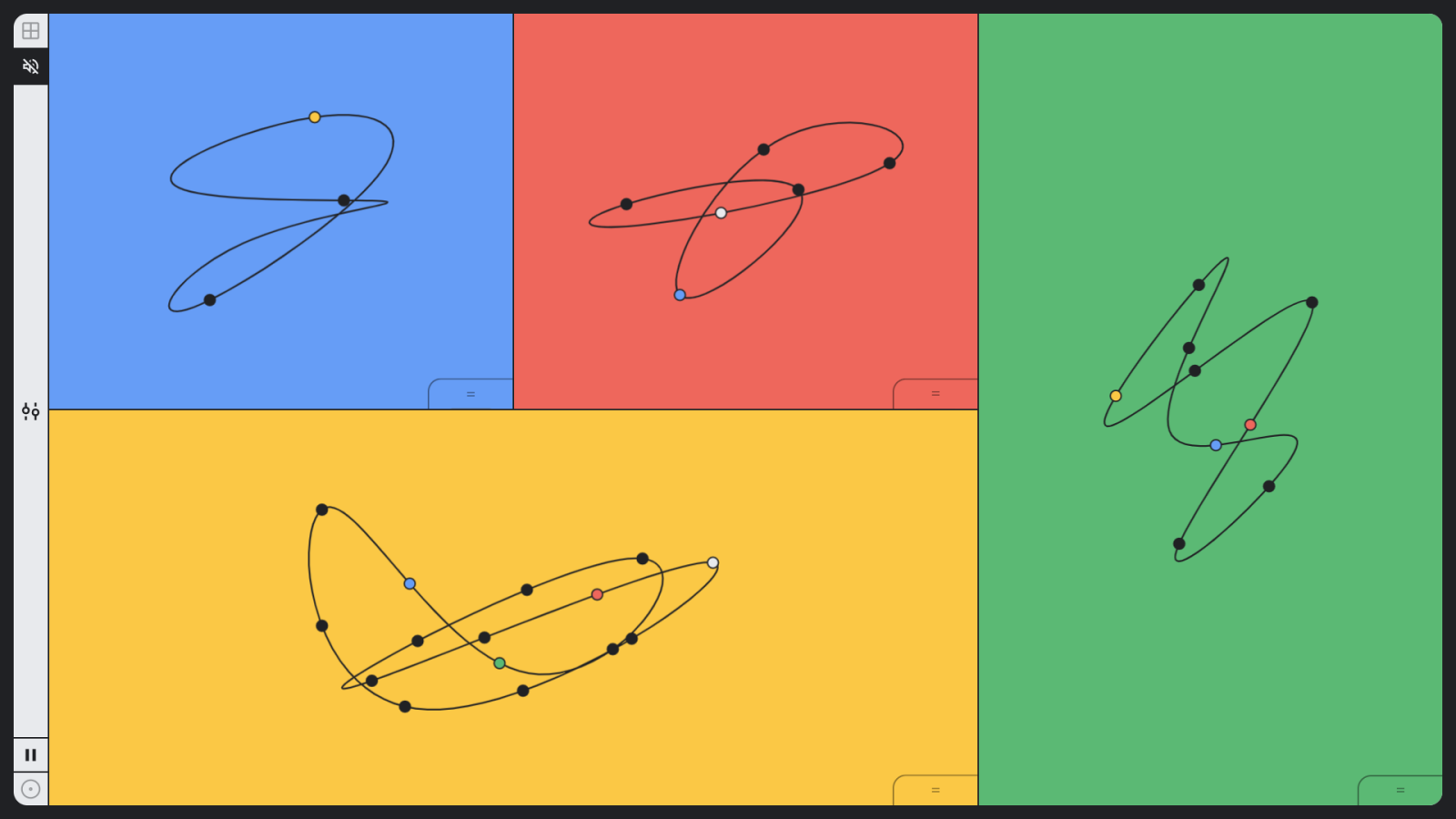
Ahead of the announcement of Google I/O 2022, the company launched a special (and quite difficult!) puzzle to tease the conference. Get your thinking caps on because we’re going to dive into this puzzle and its solutions.
Every year, the Google I/O teaser puzzle has come with a level of intrigue attached to it. Most often, someone would need to solve the puzzle before Google would reveal the exact dates of its annual Google I/O developer conference. In addition to the simple prestige of being able to say you were the first to solve the puzzle, Google would often reward the first successful person with a free ticket to the conference (an over $1000 value).
Table of contents
About the I/O 2022 puzzle
First of all, to characterize this year’s Google I/O teaser as simply a “puzzle” would undersell what Google’s crafted. Instead, this should be thought of as an online musical toy with an optional puzzle built into it. As such, the first thing you’ll want to do on the I/O 2022 teaser page is turn sound on — at least for a few minutes.
The teaser consists of four sequences (A, B, C, and D), each responsible for a different “instrument” of a delightfully chill bit of music being played. In the included control panel, you can mute (M) each of these instruments or select one to play solo (S) for a time. While those tools aren’t part of the puzzle, it shows the level of detail Google’s developers went to when creating this teaser.
By clicking/tapping on a sequence, you’re offered more controls to tweak that instrument of the song. In the top left, there are plus and minus buttons that allow you to tweak the number of beats in each measure of the song. Next to it, there’s a strip displaying the beats. By clicking any beat, you can add a note to it. These two controls, in addition to their role in tweaking the sound of the song, are the main puzzle solving elements we’ll be using today.
Each sequence starts out in a wild and tangled shape with a collection of dots strung throughout, representing each beat/note. As Google noted in their original teaser tweets for the puzzle, our goal is to “untangle” the strings. To do this, all we need to do is find the correct number of beats and placement of notes for each sequence of the song. It sounds simple enough, but the clues used to determine those placements are where things get tricky.
In fact, this puzzle is so difficult that no one solved it in its entirety before the conference dates were officially announced by CEO Sundar Pichai last month. We managed to get through half of the solution last month, but the rest of it required consulting with the merry band of puzzle makers on the Google I/O team.
Tips and tricks
As Google I/O is a developer-focused conference, the teaser puzzle is oriented toward developers. While parts of the puzzle may be solvable on a mobile device, there are times where you’ll need to use a desktop or laptop with access to Chrome’s DevTools.
More specifically, you’ll find a lot of help in the Console tab of DevTools, both in the main puzzle tab and in each individual clue’s window. If you want to try and solve the puzzles yourself without looking at the solutions below, but you need a little bit more help, you can type hint() into the console while on one of the clue pages. Most clues have multiple hints that should help steer you to a solution.
Additionally, once you have the answers to all of the clues for a particular sequence, Google has made it easy to use the console to enter the final solution for a sequence. You’ll need to use the updateSequence command, which needs a letter (A, B, C, or D) and the numbers of your final answer. Here’s an example:
updateSequence('A', '0000111100001111')
This ability to enter sequences with the console is useful, as each individual clue gives an answer in binary, and the final answer to each sequence is found by “adding” these numbers together as if they weren’t binary (0101 + 0001 = 0102 for example). The in-game controls for adding beats or changing notes are fun for treating this as a musical toy, but entering the final answer one note at a time gets tedious.
Notably, Google has also made thorough use of alt text (the accessibility text that appears when hovering over an image) in each clue. In addition to making the I/O 2022 puzzle solvable for the visually impaired, these bits of alt text can also provide shortcuts to finding the most important details of each clue’s design. Be on the lookout for them!
Lastly, while some prior knowledge can be useful for solving the clues of this puzzle, most of what you need to know can be relatively easily found with a Google search.
Sequence A solution
Google makes things pretty easy with Sequence A of the I/O 2022 puzzle. When you click the equal sign in the corner, an icon of the number 31 is revealed. This icon opens a popup window to our first clue.
Clue 1
In Clue 1, we’re given a 4×4 grid of seemingly random numbers, and in the corner, there is a button with a question mark. Clicking this offers a bit of cryptic context for the clue at hand: “The truth is primarily odd.”

This hint gives us two criteria to find “the truth.” The word “primarily” is a play on “prime,” and “odd” means we want only odd numbers. Putting it together, we want to note from this grid the prime numbers that are also odd, so 19 and 73. The number 2 is prime as well, but it’s the only prime number that is also even.
Now, how do we apply that back to the music puzzle? First, we treat the grid like it’s a simple list of numbers. Since there are 16 numbers, we’ll need to add beats until we have 16. Next, we need to add a note to the spots where 19 and 73 would be — the second and tenth positions. Here’s what putting in the final solution to Sequence A will look like:
Or, as mentioned above, you can also just use the updateSequence command in the DevTools console, like so:
updateSequence('A', '0100000001000000')
Sequence B solution
With Sequence B of the I/O 2022 puzzle, things ramp up a bit more. For starters, there are now two different notes to choose from on each beat. At the same time, there are two separate clues to be solved to find the final answer.
Clue 2
Clue 2 shows the classic T-Rex mascot of Chrome’s Dino Run game standing on green grass beneath a blue sky, and it offers the clue “Start seeing in binary.” Here, the word “seeing” takes on a double meaning, firstly referring to the dinosaur’s eye.
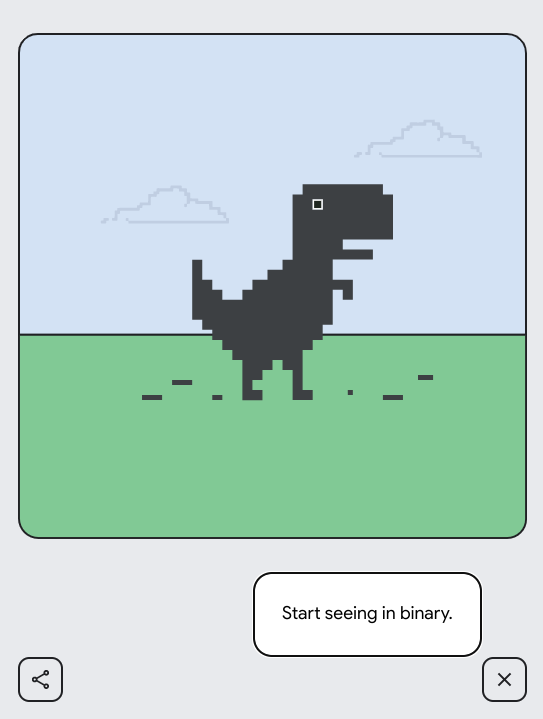
By hovering over each element of the clue, the CSS/hex color is mentioned in the alt text. Rather than being a true black, the eye is instead the CSS/hex color #202821. Next, we need to “see” that number in binary. By converting the hexadecimal to binary we get a 24-digit long number: 001000000010100000100001.
Clue 3
Next, in Clue 3, we have a 6×4 grid of the letters I and O (for Google I/O, of course) standing in for the usual 1s and 0s of binary. The hint for the clue is “What would Morton do?”
The answer here lies in a computer science term called “Z-order” or “Morton order.” Its use in computers has to do with organizing complex, multidimensional data points into a single-dimensional line. What we’ll do is follow the Z-shaped pattern of the Morton order through the grid, as seen below. This gives us a second binary number, 000010010010000100001001.

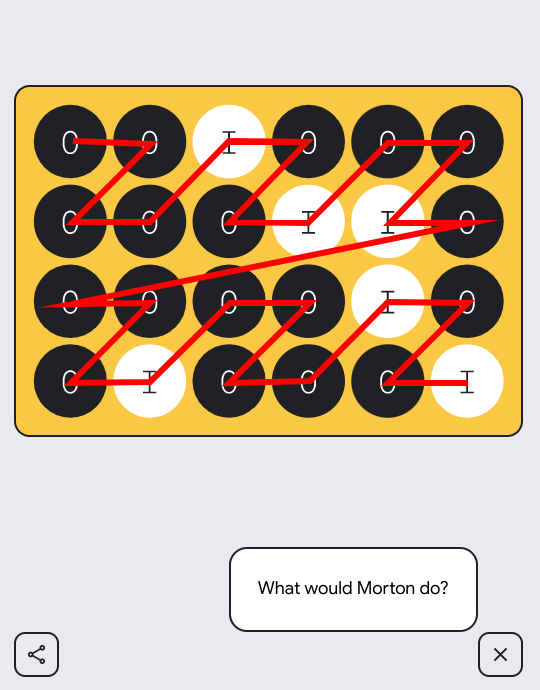
The final step of solving Sequence B lies in the way the clues are presented in the main puzzle view. They’re listed vertically, separated by a plus sign, and have an equals sign underneath. Since there are two different notes to choose from, we know we’re not looking for a true binary number. Instead let’s just “add” the two numbers together like so:
001000000010100000100001
+ 000010010010000100001001
= 001010010020100100101002
With that final number known, add beats to the sequence until there are 24, then fill in the notes accordingly. The number 1 refers to the white notes, while 2 serves as the blue notes. The solution to Sequence B will look like this:
updateSequence('B', '001010010020100100101002')
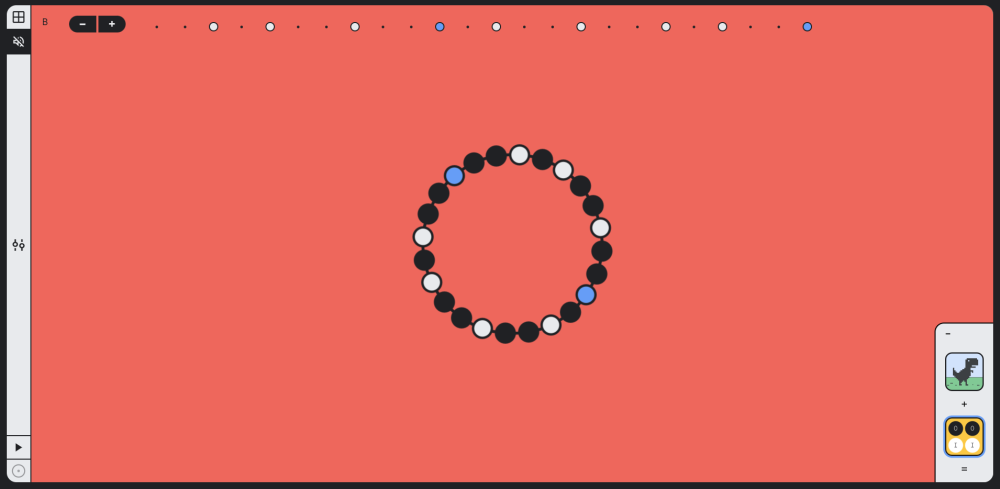
Sequence C solution
Continuing the steady escalation, Sequence C has three clues, the solutions to which need to be added together.
Clue 4
Starting with clue 4, we find a bit of sheet music featuring 12 similar phrases. The main hint is that “Not all motifs are perfect.”
Fortunately (as I can’t actually read sheet music) Google offers everything we need to know about this clue in the alt text. Each fragment of the song is fully described:
Fragment 1: beginning with an eighth note descending to a quarter note, ending with a half note
Fragment 4: beginning with an eighth note ascending to a quarter note, ending with a quarter note slurred to a quarter note
Looking at the additional hints offered in the console, we find that “Where you start is just as important as where you end” and “What goes down must come up. Or is it the other way around?” From this, we can piece together that we need to separate the fragments that “ascend” from the ones that “descend,” giving us an answer of 000100100100.
Clue 5
Next up, on clue 5, we have a grid of cards that show musical notes. These cards can be described based on four different attributes: the background color (red, blue, and yellow), the number of notes (two, three and four), the length of the notes (half, eighth, and quarter), and the direction (ascending, descending, and straight).
From the included clue — “Do you have a set perspective?” — we can find that this is a version of the classic card game SET. What we need to do is figure out which cards can be included in a valid set based on the game’s rules. In short, for each attribute, all three cards need to have the same attribute or all have different ones.
For example, the three red cards can be matched together because:
- They have the same background color.
- They have the same direction.
- They have the same note length.
- The note numbers are different (2, 3, 4).
Here are the sets that can be made from these 12 cards:


The solution to clue 5 is to mark the four outlying cards (the ones not included in a set) as 1, and the others as 0, like so: 100100100100.
Clue 6
For Clue 6, we find yet another bit of musical staff, though rather than showing the notes themselves, we simply have the “intervals” of 12 notes. This is our first hint that we need to know a bit of music theory, as the “interval” is the difference in pitch between two different sounds or notes. Once again, rather than needing to know how to read the musical staff, Google describes each note the alt text.

The main hint given is that “Without tension there is no harmony,” while one of the additional hints offered in the console is “consonance vs. dissonance.” With a bit of help from EarMaster’s online music theory book, we can find a list of note intervals that are considered “dissonant” or tension-building rather than pleasant sounding.
As only the seventh and tenth intervals in the staff are considered dissonant, we get an answer of 000000100100.
Adding all three of these solutions together, we get a final answer for Sequence C of 100200300300. Here, 1 is the yellow note, 2 is the red note, and 3 is the blue note, or as always you can enter the solution through the console like so:
updateSequence('C', '100200300300')
Sequence D
In our final batch of clues, we leave behind the musical theme and go a level deeper, needing to add together four different answers.
Clue 7
In clue 7, we’re shown a plane ticket, adorned with a collection of flags. These are the flags used in the International Code of Signals to represent (among other things) the various letters of the alphabet.
Based on that, we can read the plane ticket as “HEL → ??? → SFO,” which means a trip from the Helsinki Airport to the San Francisco International Airport with a layover in between. Beneath the ticket, there are five options of potential layover airports: Copenhagen (CPH), Sydney (SYD), Tokyo (HND), Hanoi (BAI), and Cape Town (CPT).

Next we look at the included hint of “not direct, but concise.” Of the provided options, the most concise route from Helsinki to San Francisco is through Copenhagen, being thousands of miles shorter than the other routes. This can be easily measured with Google Maps’ distance tool.
The last step is to turn the airport code, CPH, into a binary answer. To do this, we convert the letters from simple ASCII text to binary, offering a 24-digit solution of 01000011 01010000 01001000.
Clue 8
Clue number 8 is the one that has given us and other solvers the most trouble. In fact, in response to feedback, Google’s puzzle designers revised the design to leave less room for alternative interpretations.
This clue presents a tennis court, in the middle of which is a series of 54 “points” indicated by black and white pill shapes. In the corner, there’s also an indicator of who is serving, specifically “player 1” according to the alt text.
The main hint is “By now you’ve learned the ins and outs,” and the only additional hint in the console is “Dueling during deuce.”
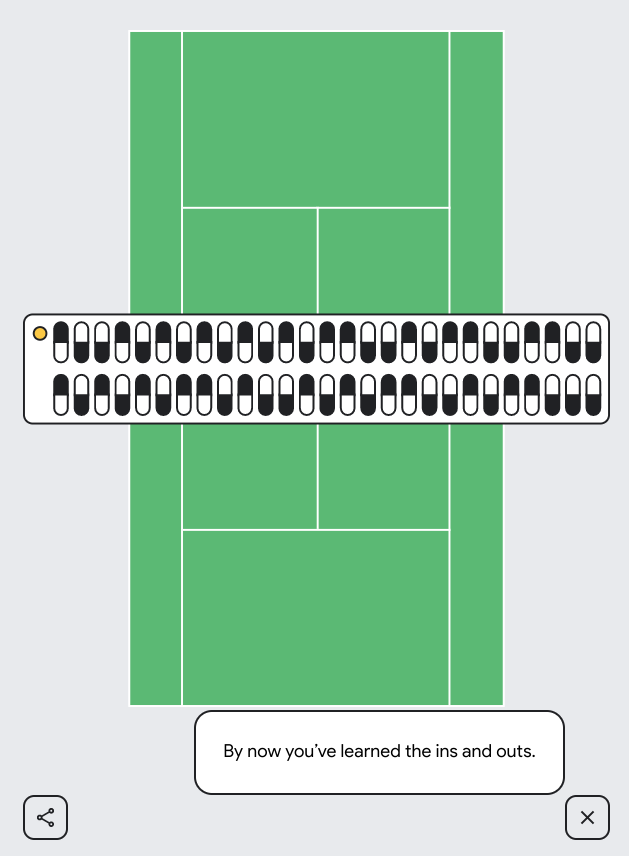
To puzzle out this particular clue, we need to get familiar with how tennis is scored and how the score is called. For starters, scoring goes 15, 30, 45 for the first three points. If one player reaches 45 before their opponent and scores again, that player wins.
Otherwise, if both players reach 45, the game enters a state of “deuce.” From deuce, when either player scores, that player then has the “advantage.” If the player with advantage is the player serving, the score is called as “advantage-in,” otherwise it’s called as “advantage-out.” When one player has advantage, if the opposing player scores, the game goes back to deuce. Lastly, if the player with advantage scores again, they win the game.
Returning to the given clue of “By now you’ve learned the ins and outs,” it seems we need to use the point markers to keep track of the game’s score and pay attention to the calls of advantage-in and advantage-out.
As the serving indicator is on the upper side of the board, we’ll assume that the when the black mark is on the upper side of the point indicator that the serving player has scored, and vice versa. If we assume things start from a brand new game, the game enters deuce (45/45) after the sixth point. From that point onward, we find 24 instances of advantage-in or out, giving us a solution of 00001001 01000011 00010010.
Clue 9
In comparison to the previous clue, clue 9 is a piece of cake. We’re shown a grid of 24 sets of coordinates, along with the hint “O is for office.” All we need to do is enter them into Google Maps and look for the nearest Google-owned location.

While most of the locations are office buildings, there are also a handful of Google data centers in the list. And if “O” (or 0) is for office, then the other locations must be 1.
Another important factor of this puzzle is the order in which we need to read the answers. By repeatedly tapping the Tab key, we find that we need to follow the list from top to bottom then left to right. This gives us three columns of eight for a final answer of 00000010 01011010 00001011.
Clue 10
For the final clue of Sequence D, we’re presented with a grid of clocks, along with the hint “It’s 12:30 in London.” Unhelpfully, none of the clocks show AM or PM. More so than the previous clues, we need to rely on the alt text in this puzzle as each clock is also associated with a location/time zone, like so:
Buenos Aires, 9:30
Venezuela, 8:30

From the hint offered in the console, “Before and after UTC,” we can surmise that we need to sort out which time zones are positioned before GMT/UTC and which ones are after. For example, the time zone for Buenos Aires is UTC-3 while Hong Kong is UTC+8.
On the assumption that the time zones before UTC are 0 and the ones after are 1, we get a possible answer of: 00010001 01010011 00001011.
With the answers to all four clues now secured, we can add them all together and return to the DevTools console in the main puzzle window.
updateSequence('D', '010110230403103201013032')
Offsets / The Golden Record
The final step of completing the Google I/O puzzle’s symphony is to adjust the offsets. Essentially, we need to tweak the starting points of the four melodies to be better in sync with one another. To do this, click on the record-shaped icon in the bottom-left corner of the app.
Doing so will slide the previous puzzle out of the way to reveal the four “untangled strings,” encircling one another. In the bottom-right corner, you’ll once again see an equals sign revealing the 11th and final clue.
Clue 11
To keep us all on our toes, Clue 11 is actually four individual mini puzzles to be solved. In each puzzle, we’re shown (in one way or another) what the sequence looks like when it’s set to the correct offset. Instead of showing numbers, each sub-clue shows the letter of the note played, meaning we’ll also need to solve turning the letters back into numbers.
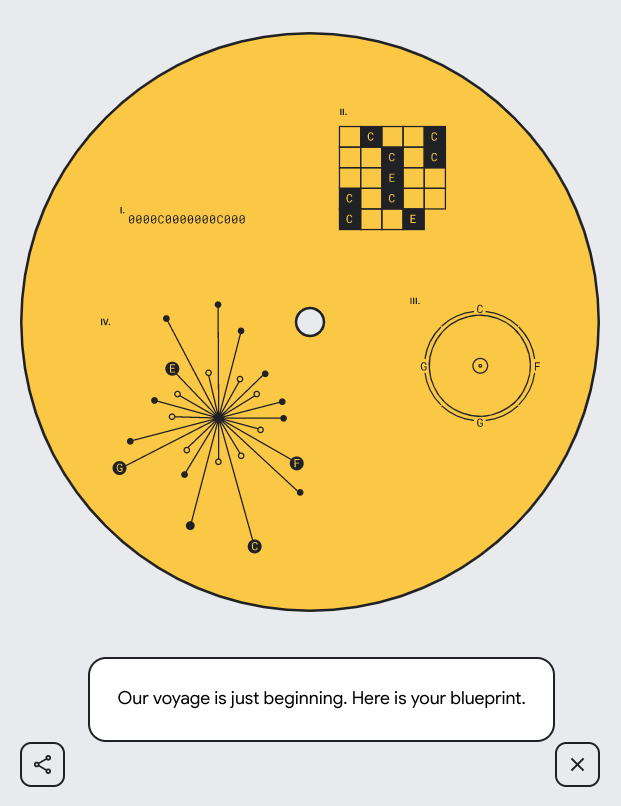
Just like when entering the answers to the sequences, it’s also possible to adjust the offsets using the DevTools console using the “updateOffset” command, as you’ll see in the answer guides below.
Offset A
To kick things off, we find a string of zeros and the letter C, giving the appearance of slightly altered binary code.
0000C0000000C000
We can assume that the letter C is standing in place of the number 1 in the answer to Sequence A. So let’s take a look at the original answer (marked O) and what the correctly offset version (marked C) should look like.
O: 0100000001000000
C: 0000100000001000
By moving the leading digit to the end, one by one shifting the start point, we find that we need to shift five spaces over to get the new answer. That means our offset is 5.
updateOffset('A', 5)
Offset B
In the second mini puzzle, we see a 5×5 grid of squares, minus the bottom-right corner, that are either blank or contain the letters C or E. Reading it left to right, we get a pretty easy to follow sequence.
0C00C00C 0C00E00C 0C00C00E
Just as there are only two uses of the number 2 in the answer to Sequence B, there are only two uses of the letter E in this offset clue. As such we can look at it again like so:
O: 001010010020100100101002
C: 010010010100200101001002
Once again, by adjusting the starting digit, we find that the correct offset is 11. At this point, you may have noticed a pattern to the answers, but let’s carry on to the next offset!
updateOffset('B', 11)
Offset C
Continuing clockwise, our next puzzle shows a few circles in the shape of a vinyl record, around which there is another circle formed of broken up line segments and four letters (read clockwise): C, F, G, G. Just like the solution to sequence C has a note followed by two blanks, this offset puzzle has a letter followed by two lines segments.
Next we need to figure out which notes correspond to each number. This is easy to do thanks to the repeated letter G, which corresponds to the repeated number 3 in the answer to sequence C. That means the preceding F should be the number 2 and that C should be 1. Comparing the offset shown to the original answer we find the following:
O: 100200300300
C: 100200300300
That’s right, they’re one and the same. The first instinct we had for this part of the puzzle was to leave the offset at 0, since no change was needed. But, there’s actually more than one way to look at it. For reasons that will become clear soon, we need to loop all the way around to the beginning, giving us an answer of 12.
updateOffset('C', 12)
Offset D
The final step of this journey through puzzle solving looks a bit like a star, with twenty four points radiating out from a center point, with lines of varying lengths. The lengths of each line correspond to a particular letter, ascending in length in the order of E, F, G, and C.
Solving this puzzle the hard way, we could measure the length of each of the lines and figure out the corresponding letter that way. Doing things the easy way, we can use the alt text for each point to reveal the combination of letters:
GF0E0EE0FG0C0GE0GF0E0EG0
The trick to figuring out which letter is which is in the “EE,” the only repeated letters in the clue. Returning to our answer to Sequence D, we find the only pair is “11.” Everything falls into place from there, giving us our original and corrected answers:
O: 010110230403103201013032
C: 320101102304031032010130
To get this offset right, we have to go nearly full circle, with a final answer of 22.
updateOffset('D', 22)
Puzzle solved!
With that final offset solved and entered, you’re brought to the big finale of the Google I/O 2022 puzzle. Had the puzzle been solved before the event was fully announced, the offset numbers (5, 11, 12, 22) would have played their part in revealing that Google I/O will take place May 11 – 12, 2022 — otherwise written as “5/11 – 12/22.”
Our special thanks to the Google I/O puzzle design team!
FTC: We use income earning auto affiliate links. More.





Comments